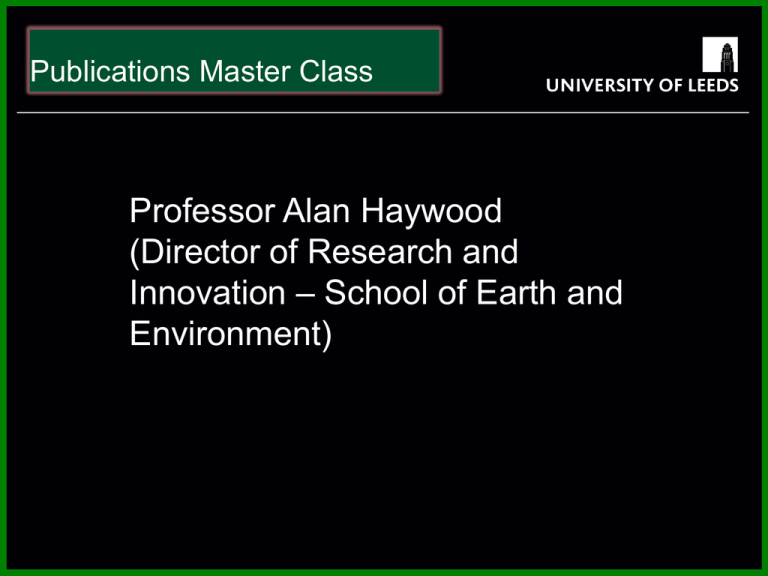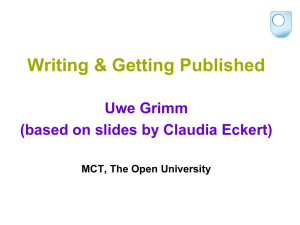Publications Masterclass notes - School of Earth and Environment
advertisement

School of something Publications Master Class FACULTY OF OTHER Professor Alan Haywood (Director of Research and Innovation – School of Earth and Environment) Why do we publish papers? • To communicate our work to others • To satisfy our funders e.g. NERC • To satisfy our egos? • To raise the profile of the School/Faculty/University • To enhance the School’s position in national research assessment exercises e.g. RAE2008, REF2014 • To enhance our promotion prospects (CV etc) • To get our next job So what’s in it for me? • Improved job prospects (a CV with several GOOD publications on it will distinguish you from other applicants) • Makes it much easier to write up your PhD thesis • Parts of your thesis will have already been validated by external PEER REVIEW • Tremendous sense of satisfaction in seeing your work in print Isn’t it a lot of extra work? • Writing papers brings a sense of discipline to your research – it makes you more organised! • It is a good incentive to get to grips with graphics software e.g. Corel Draw, Adobe Illustrator; you have to produce good quality diagrams to illustrate your paper • The papers you write can be incorporated into your thesis – so your thesis is building up as you go Planning your research • A successful PhD has to contain “material of publishable quality” – so why not get ahead of the game and plan to publish some key papers as you go along? • Discuss a “publications plan” with your supervisor(s) – early on in your research; they are the best people to advise on which aspects of your work will make good papers. Such a plan will provide a “structured framework” for your research Choosing the right journal Some Do’s and Don’t’s . Don’t expect to be writing papers for Nature in your first year! BUT it can happen! • Decide on your target journal before you start to write. Be ambitious in your choice! Discuss this with your supervisor. What is the journal’s ISI Impact Factor? Is it recognised as a good journal in your field? • Does your work fit the Journal ? Has it published papers on similar topics recently? What is your paper about? What is the “story”? • What is the core idea that you want to get over? • Keep the message simple – ideally just a single idea or “message” • Plan out the diagrams and data tables before you start. Do you have all the data you need to substantiate your story? • Look at some recent papers in the journal you have decided to publish in. Check the Instructions to Authors (usually on the journal web site) and follow them! Does the Journal have an on-line manuscript submission system? Does the “evidence” support your story? The publication “cycle” • Write a draft of your paper (manuscript) • Get your supervisor/colleagues to comment on it • Revise manuscript (this may require many iterations) • SUBMIT your manuscript • WAIT ( several weeks to several months) for comments from external reviewers (selected by the Editor of the journal) • RECEIVE Editor’s decision – e.g. Minor Revision, Major Revision, Reject • REVISE & RESUBMIT – and maybe REVISE again! Editors are your fellow scientists So be respectful in your communications! Writing the Abstract • The hardest part! • Write this last • Practice writing “structured abstracts” • Look at some examples in different journals • DO NOT cut and paste from the main text – the Abstract should stand alone – it should “wet the appetite” of the reader Are you up to date with the current literature? Citing the relevant literature • Have you cited all the relevant literature? • Have you actually read and understood what you cite? • Be very careful not to plagiarise by copying parts of other’s papers. Many journals use software to check this. The “power of the internet”! Develop your writing style Writing Style • Keep it simple. Use short sentences with a minimum of subordinate clauses • Generally use “third person, past tense” – although increasingly “ I did this/ We did that” is becoming commonplace • Check spellings and conventions University Publication Policy Leeds University has a broader publication policy in that all papers published from 01 April 2015 must be Open Access. http://library.leeds.ac.uk/university-publicationspolicy If you have any questions on this please email: seepublication@leeds.ac.uk There is also information on this available on the SEE staff pages under publications. University Publication Policy From 1st April 2015 all journal articles and conference papers accepted for publication must be deposited by the author in the institutional repository (Symplectic) no later than 3 months after acceptance. From Symplectic publications will automatically be uploaded to White Rose Research Online (WRRO). All research outputs not subject to copyright restrictions, commercial or confidentiality constraints must be open access. Adhering to the University policy will ensure that HEFCE and RCUK requirements are also met. Questions?
